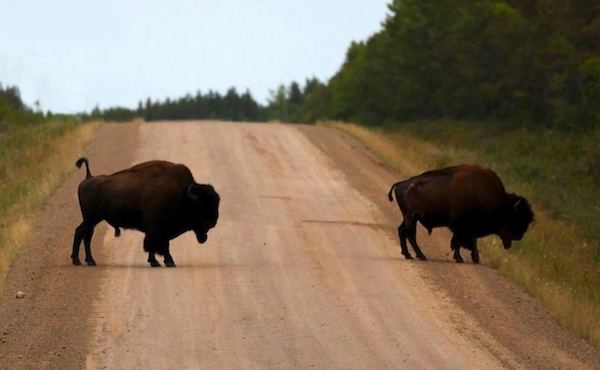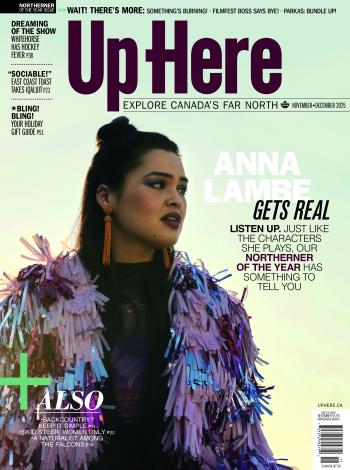My career as a renewable resource officer in the Northwest Territories varied drastically from one community posting to another. Fort Liard and the Liard Valley are known for their re-introduction of wood bison.
Upon arriving in the small hamlet I learned quickly to respect these majestic beasts. They would wander into the hamlet for green feed and to avoid wolf predation. I would repeatedly get calls and promptly attempted to relocate these pesky giants away from gardens, the downtown, and the airport.
Over time the animals and I developed an interesting relationship. My knowledge of which animal played the lead role within the group made my life easier. An old bison cow that was missing a horn sheath on her left horn proved to be the matriarch of the herd. When attempting to move the herd the matriarch always ensured that all animals followed. If I was successful in getting her to move the rest soon followed.
I swear that after our continuous encounters they recognized my green government truck. I would often find them wandering within the community and walk them out of town. They would then wander back into the hamlet and end up in my backyard laying around my patrol truck. It was as though they understood and realized that they were safe there.
I was often awakened at night by bulls rubbing up against the house or digging in my garden. I would get up in the morning and get ready for work. I would go out to my truck, get in and escort them down the drive and along Main Street past the office and down to the helipad where they spent countless hours feeding. This became so common that News/North, a Yellowknife newspaper, reported on it and often portrayed cartoons of bison walking down the streets, feeding on local gardens. I remember removing a hubcap from a cow bison calf and cutting Christmas lights and extension cords away from their horns. They remained docile and you would think they knew I was trying to help.
One of the most common complaints was that they left manure cow patties all over town. Folks kidded that they should be forced to wear diapers in the hamlet to minimize their patties within the hamlet. Gardeners never lacked a readily available source of manure all the while worrying about having the bison help themselves to their gardens. Fence didn’t prove effective as the bison could easily jump a five-foot fence or plow through to feed on your garden.
The Liard Valley has been referred to as the Tropics of the Arctic and is known for its great weather and as such it produces phenomenal gardens. Bison love to share all crops. After years of interacting with some 60-plus animals on a daily basis, I swear the bison had become tamer and less of a problem around the community. They were learning that there were certain areas where they weren’t welcomed such as the airport and the community graveyard. Fences were erected to encourage them to stay out of specific areas and I even went as far as to plant feed, put out salt blocks in recently harvested cut blocks to enhance them to stay away from the hamlet core. The learning curve was very slow and our interactions remained respectful, as these animals are extremely large and strong.
I had the misfortune of rolling over on my ankle and ended up with a walking cast. Upon returning to Fort Liard I was called upon to remove bison from the ball diamond as the community ball tournament was beginning. I hobbled out on to the ball diamond on crutches amongst 30 bison eating grass. The bleachers were full of players and fans waiting to start playing. I banged my crutches together, walked towards them and had them walk through the gate while others jumped the fence. They were all out and I slipped on a cow patty breaking my cast and having to go out to get it replaced. As the doctor was removing the old cast he noticed dark matter only to determine it was bison poop. Let’s just say he wasn’t impressed that I broke my cast within hours and refused to recast my leg with a walking cast.

In 1998, the superintendent contacted me and said 62 new bison were coming to Fort Liard. I was to set up for yet another re-introduction of bison from Elk Island National Park. Sixty-two animals were to arrive in February and released within a corral where I would feed them for four to five weeks to habituate them to new area. I built the enclosure using a D8 Cat and hired a crew to fence the area. I ordered feed for them as well as salt and mineral licks to meet their nutritional requirements.
Upon arrival, I noticed these animals were very stressed and unpredictable. I fed and watered them daily and yet after a month of this they still were wild compared to those who were lying in my yard and around town. The resident Liard Bison often travelled to the herd being held within the pen and checked each other out.
I was to release them to the wild within a week only to find out that a helicopter had buzzed the pen and caused them to stampede and rush the gate, destroying it and getting out. They then proceeded to run down the road to B.C. and almost to Fort Nelson, 220 kilometres, away before we could get ahead of them and settle them down.
With great effort most were penned up and carried back to the Liard area. Some animals were destroyed to avoid intermixing with domestic bison located in Fort Nelson. Of the 62 animals transplanted, 58 were rounded up and returned to the Liard Valley. The experience re-affirmed that bison were wild and unpredictable.
After a period of time one couldn’t tell the groups apart. The newly introduced animals were calming down and blended in with the resident herd.
I now live in Fort Smith on the edge of Wood Buffalo National Park and often encounter bison while traveling Highway #5 and the Pine Lake Road. These animals are the same type as those found in Fort Liard but that is where the similarities end. These guys are wild and respond much differently to those from Fort Liard. They are skittish and often known to stampede when approached. I guess the fact that they are hunted regularly and aren’t close to populated areas on a regular basis explains the differences. Yet they often are observed demonstrating similar behavior to those in Fort Liard.
Just this past summer we were traveling to Hay River and noticed a herd of 20 animals lying on the pavement with a vehicle parked on the far of the group. As I approached the group I noticed that the adults were surrounding young calves of the spring sleeping on the warm pavement in a similar fashion to those in Fort Liard. I then kept moving toward them to force them to get up and move off the road. The young bulls were rambunctious and I could tell they were reluctant to move off the highway.
Upon crossing the area I stopped and asked the driver of the vehicle on the far side of the herd if she was okay. She stated having been there for two hours honking her horn and flashing her lights in an attempt to get the animals to move. She was very afraid of the gentle giants and asked that I escort her through the herd before heading out on my way.
This occurrence reminded me of a similar example in Fort Liard where I was called out on the highway to assist a trapped motorist who had become surrounded by a larger group of bison. In that instance, I merely drove up to the herd, got out of my truck and walked into the herd to escort the stranded tourist who had been terrified of them for some four hours without other vehicles coming by. The Fort Liard Bison were known animals that frequented the hamlet and were known to me. They responded to my voice and got up and relocated off the highway taking their young with them. In contrast, the Wood Buffalo National Park Bison encounter demonstrated wild behavior with erratic movement and much more of a threat.
In Fort Liard, I was often referred to as the Bison Whisperer with a death wish.
I recently returned to Fort Liard to encounter a group of bison within the hamlet. They portrayed much different behavior towards humans as a result of the introduction of a limited harvest. Apparently, the herds spend a lot less time within the community and react differently to human interaction. I guess that they now look at humans from a different perspective and are wary of humans.
I still enjoyed the many close interactions I had with these majestic animals at all hours of the day and night while living in Fort Liard and I will always remember those interactions vividly. I think my respect for bison will never change even though my Wood Buffalo National Park interactions differ from those experienced in Fort Liard in the nineties.
Michel J Labine retired on the Banks of the Slave River, a multimedia Métis artist specializing in custom Northern stained glass creations. With 38 years in the NWT and Nunavut, having worked over 27 years as a resource officer, he incorporates his travels, knowledge, and experiences into everything he creates.









